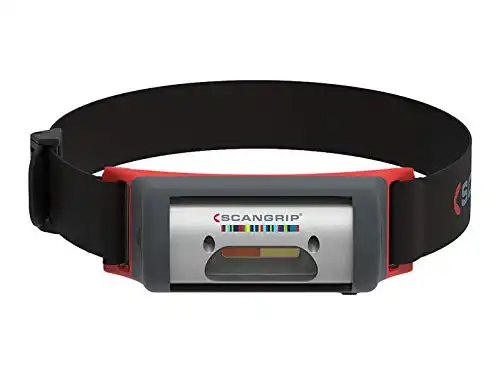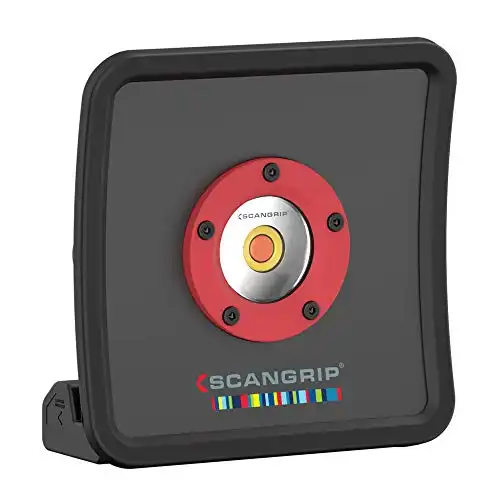Detailing your car requires the right mix of lighting to make sure you’re getting the best finish you can for your paint.
Even if you’re only a weekend warrior, getting your garage detailing lights dialed-in can help you get significantly better results the next time you detail your car.
The best lighting for detailing your car is a combination of the following:
- Bright overhead lighting to eliminate shadows
- Handheld or tripod lighting for brighter lighting in the general work area
- Headlamps to illuminate the body panel you’re currently polishing
- Swirl Finder lights to detect hard-to-find paint imperfections
To be completely transparent, most people don’t need everything on the list. You’ll naturally need specialized lighting as you get more serious about detailing your car.
When building your car detailing light setup, I recommend starting with super-bright overhead garage lighting. Then, add additional pieces as you need to.
I-Match 2 Professional Color Matching Headlamp |
Scangrip MultiMatch R 1,200 Lumen, High CRI Detailing Light |
Scangrip MATCHPEN R |
|
Primary Rating:
4.0
|
Primary Rating:
4.8
|
Primary Rating:
4.2
|
The rest of the article will look at my recommendations for each. In many cases, I’ll link to a detailed review of my favorite detailing lights for each situation.
Let’s get started.
Best Handheld Detailing Lights: Scangrip MultiMatch R
If you work in a brightly lit garage, you’ll need smaller lights to illuminate the sides of your car.
You can do that in a few different ways, but my favorite is the Scangrip MultiMatch R.

This handheld light puts out 1200 lumens at five different color temperatures ranging from 2500 Kelvin to 6500 Kelvin. That’s a ton of light from a small package!
Scangrip figured out that warmer color temperatures work better for finding swirls and scratches on lighter-colored cars. Darker-colored cars need a cooler light with a higher color temperature.
This allows you to switch between 4500K for lighter-colored cars and 6500K for darker colors.
The MultiMatch R has five power settings ranging from 10% output all the way up to a blinding 100%.
Don’t look directly at the bulb when you turn it on at 100%. I may or may not be speaking from experience there…
The built-in rechargeable battery lasts up to ten hours, depending on the power setting. There’s also an LED readout to let you know how much juice is left.
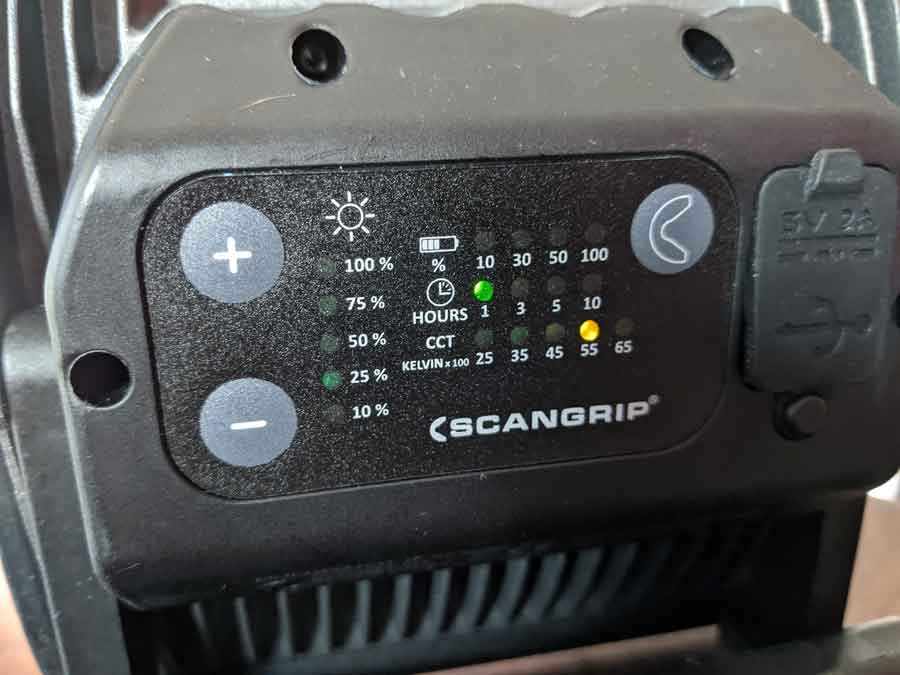
Although there is a hole to let you use Scangrip’s tripods (rolling or fixed-leg), I prefer the magnetic base.
It’s powerful enough to attach to any magnetic surface. I put it on my Gladiator GearDrawer and just wheel it around whenever I need to move.
All in all, the Scangrip MultiMatch R puts out a ton of light at all of the popular color temperatures for car detailing. It’s a little expensive, especially compared to the budget lights you get from Harbor Freight.
However, it’s a high-quality, heavy-duty light that should last a long time.
Best Headlamp for Detailing: Scangrip I-Match 2
I’m not a fan of headlamps. I’d rather use a penlight or a handheld light than have anything on my head. However, a professional detailer that I spoke to swears by this type of lighting.
When shopping for a headlamp, it’s worth asking HOW you need to use it.
Any old light will do if you’re looking for something for interior detailing. You want something that puts out enough light, but color accuracy isn’t a big deal.
But if you’re looking for a headlamp for exterior work, you want one with a very high CRI (Color Rendering Index). That ensures the color of the paint looks the same under your light as it will outside in direct sunlight.
If you need a high-CRI headlamp for paintwork, the Scangrip I-Match 2 is tough to beat.
The Scangrip I-Match 2 is a color-matching headlamp with an internal rechargeable battery that should last about five hours.
What I like about the I-Match 2 is that it has two color temperatures, 4500K and 6500K, and only weighs about a third of a pound.
Another cool feature is the hands-free, gesture-based power switch. To turn it on and off, wave your hand twice in front of the light, and it’ll switch on and off.
Scangrip puts the same quality lighting in their headlamp as they do their larger MultiMatch R above. So again, I don’t think you need both of these products. Just pick the one that works for you.
Best Swirl Finder Penlights: Scangrip Matchpen R
If you’re serious about car detailing, you need a penlight to find swirls and imperfections you wouldn’t see using any other light.
Unlike a handheld light, the point of a penlight isn’t to illuminate your work area directly. Instead, you hold it at an angle so it illuminates scratches and imperfections that you missed on the paint’s surface.

As Matt from Obsessed Garage says, they “will humble you when you’re polishing. When you’re checking your work after polishing, this will really tell you how you’re doing.”
My new favorite color-matching penlight is the Scangrip Matchpen R.
Like their other products on this list of the best detailing lights for garages, the Scangrip Matchpen R has two color temperature options. You can switch between 4500K and 6500K at the touch of a button.
While it only outputs 100 lumens, it can focus the beam of light anywhere between 10° and 45°. It also has an internal rechargeable battery that can be recharged from any USB port.
The longtime favorite penlight, the Rupes LL150, is similarly priced but only has one color temperature option and runs on AA batteries instead of a rechargeable battery.
That means the Scangrip Matchpen R offers more versatility and better features at the same price point, giving it the win in my book.
Best Garage Lights for Detailing: Hykolity LED Shop Lights
Proper lighting begins with your overhead lights. Last year, when upgrading my garage lighting, I did a lot of research and testing.
I knew I would do occasional car detailing in my garage, so I wanted to go overboard with my overhead LED lights.
Basically, I wanted my garage to glow in the dark.
A typical two-car garage needs about 20,000 lumens to have adequate lighting. To eliminate shadows so I could properly work on my car, I tripled that to 62,000 lumens for my entire garage.
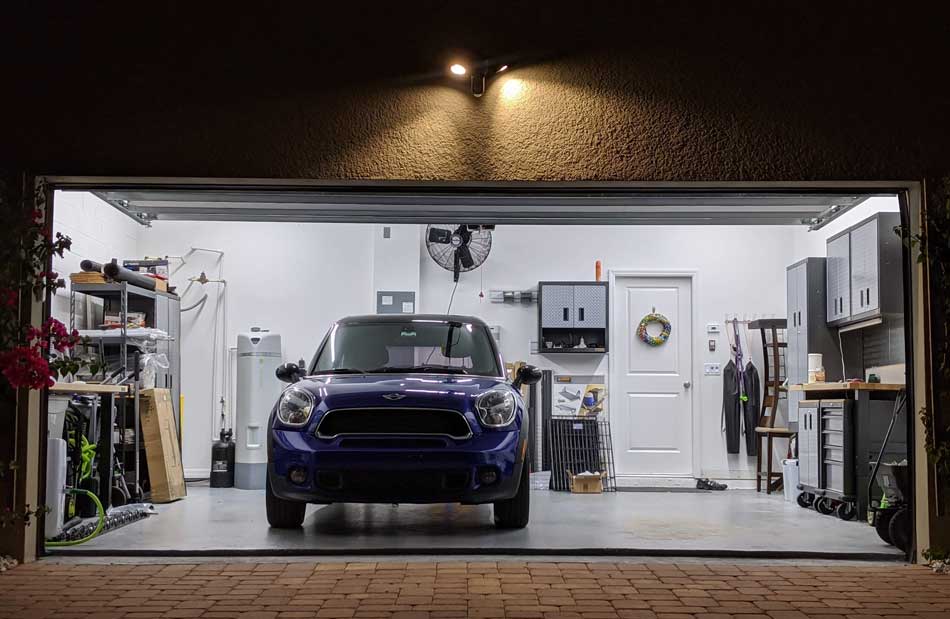
I knew I wanted LED lights rather than halogen lights or compact fluorescent lights.
LED bulbs are more energy efficient, have better color accuracy, and don’t take to warm up.
When testing, I looked at six different LED shop lights to see which ones performed best before using a combination of 4′ and 8′ Hykolity LED light fixtures.
For me, they were the perfect option.
Their performance was impressive! They had the highest output of lumens per watt (efficiency) and lumens per dollar (cost) of anything I tested. I could also hardwire them into my existing wiring and control them from the light switch.
At 5000 Kelvin, they provide a cool-white light that brings out the detail in what I’m looking at without being ‘too crisp’ and making my eyes strain more than they need to.
Quick note: When buying overhead lighting, choosing low-bay rather than high-bay lighting is important. High-bay lighting is designed for super-high warehouse ceilings and won’t work effectively in home garages.
Why High CRI Lighting Is Critical
Did you know that not all CRI lights are the same?
I’ve already given him a shout-out earlier, but I have to credit Matt at Obsessed Garage for this. In one of his videos, he mentioned that most lights use the average of the first eight color values to get their overall color rendering index (CRI) score.
The problem is that there are actually FIFTEEN different color values, not eight!
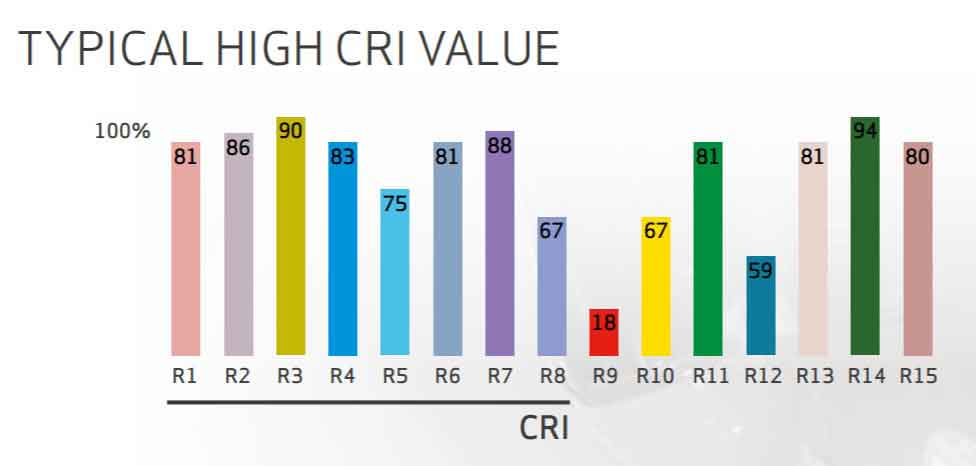
Even though the typical high-CRI light does really well at rendering the first eight values, they might not be as good on the remaining seven.
If having a color-accurate light is essential for paint correction work, then you’ll want to ensure that your light is accurate over all fifteen rendering points. Most Scangrip detailing lights will have this certification, as will other top-level brands.
Why Does This Matter?
There’s a concept in color science called illuminant metamerism. It helps explain why the same object can appear to be different colors under different lighting conditions.
My favorite example of this is the Lotus Carlton. It’s an early-1990s car that came in a British Racing Green paint color that looked black in all but direct sunlight.
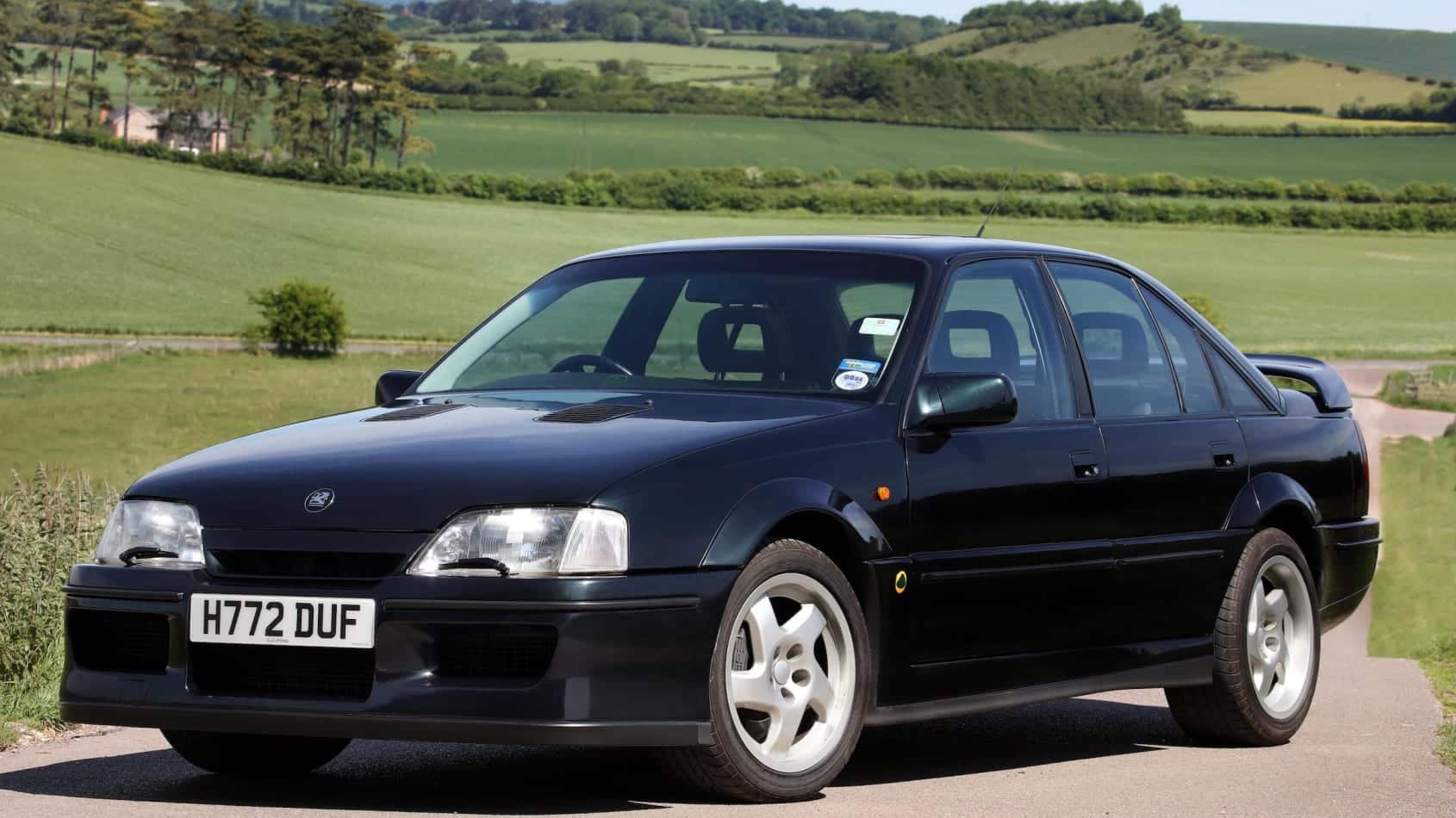
Why did this happen?
It’s because of the light source.
Let’s break this down with an easy-to-understand example:
Imagine you have a green apple. Under the bright sunlight at noon, the apple looks brightly green, vibrant, and full of life. This is because the sunlight is a balanced light source, accurately showing colors.
Now, take the same apple and look at it in your kitchen under a fluorescent light. Suddenly, the apple might not look as vibrant. It might even appear duller or have a slightly different shade of green.
This is illuminant metamerism in action…and why high-CRI lights are so important to the detailing community.
How Proper Lighting Helps with Paint Correction
Different lighting conditions, from the bright sunlight to the shade, can dramatically reveal the imperfections in a car’s paint job, such as scratches, swirls, and areas of oxidation. Auto detailers understand this well and use a variety of lighting setups to ensure every imperfection is identified and corrected.
Bright sunlight is the perfect light for highlighting imperfections. However, it’s not practical to detail a vehicle outside in bright afternoon sun.
This is where artificial lighting comes into play.
Use want to use a combination of general, focused, and specialized lighting to meticulously assess and correct the paint condition:
- General Lighting: This is the foundational layer of lighting used to illuminate the entire vehicle. It provides a broad overview of the vehicle’s paint condition, allowing detailers to assess the color, gloss level, and overall uniformity. General lighting typically involves ceiling and wall-mounted lights that flood the workspace with light, enabling a first-pass evaluation of the car’s exterior.
- Focused Lighting: After the initial assessment, focused lighting comes into play. This type of lighting is more intense and directed, usually provided by handheld lights or lights on adjustable stands. Detailers use focused lighting to inspect each panel closely, identifying specific defects and imperfections that need correction. It allows for a targeted approach, ensuring no blemish is overlooked.
- Specialized Lighting: Specialized lighting is used for the fine-tuning phase of paint correction. These lights, often referred to as swirl finder lights or pocket lights, offer a detailed view to spot the remaining defects after each polishing stage. Specialized lighting is crucial for identifying the most stubborn or minute imperfections, ensuring a flawless finish before moving on to the next section or concluding the correction process.
Wrapping It Up
A flawless paint job takes more than just skill and patience. You need the right tools, especially when it comes to lighting.
The difference between a good and a great finish often comes down to how well you can see what you’re doing.
We’ve seen that the best garage lights for detailing include a combination of overhead lighting, handheld work lights, headlamps, and swirl-finder lights.
Here’s what we recommend:
- Scangrip MultiMatch R handheld detailing light
- I-Match 2 headlamp
- Matchpen R swirl-finder light
Starting with these lights lets you build a lighting system that meets your detailing needs head-on.

